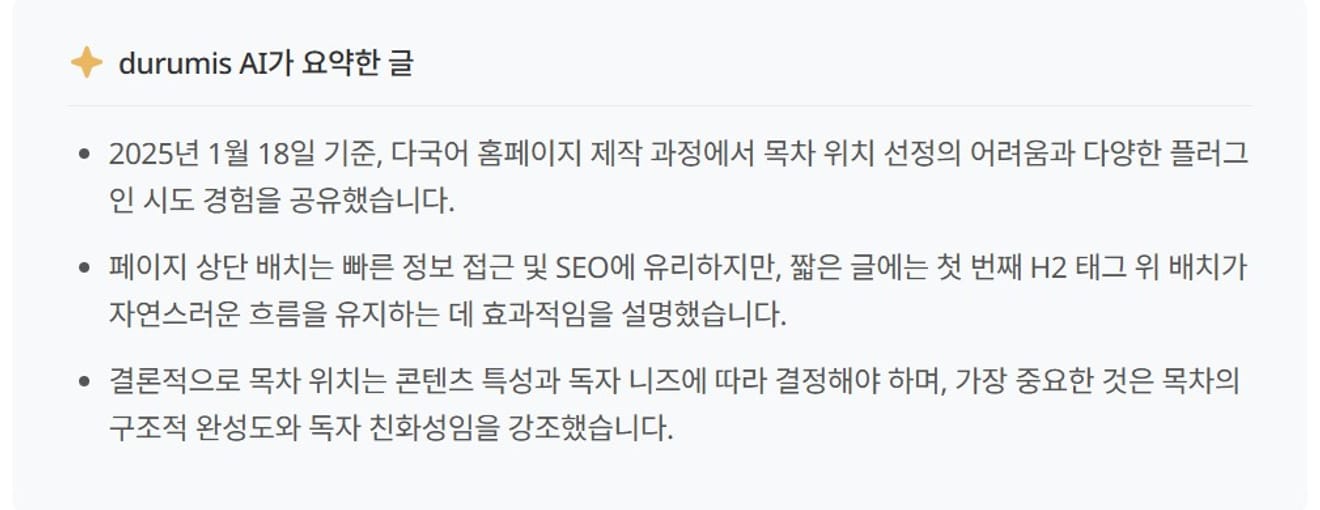Deciding on the placement of the table of contents was a real head-scratcher. I suspect durumis also put a lot of thought into whether to place the automatic summary at the top or bottom. The process of deciding on the table of contents was similar. First, choosing a table of contents I liked was incredibly difficult. While there were more options than I expected, finding one that matched my chosen WordPress theme proved extremely challenging. Because of this, the number of times I uninstalled and reinstalled table of contents plugins alone exceeded 10. In the end, I chose a free plugin, and this post will cover the process following its installation.

When placing a table of contents in WordPress content, its position can affect both user experience (UX) and search engine optimization (SEO). Whether to place the table of contents at the top of the page or above the first H2 tag depends on the content's purpose and the reader's behavior patterns. I've compared the advantages and disadvantages of both options and summarized when each is appropriate.
Placing the Table of Contents at the Top of the Page (First Line)
Placing the table of contents at the top of the page allows readers to immediately grasp the structure of the content upon opening it. This is especially suitable for long articles or detailed guides containing a large amount of information. From an SEO perspective, if the table of contents is located at the top, search engines are more likely to highlight it and display it as a Rich Snippet. It is also useful for content such as FAQs or tutorials where specific information needs to be found immediately.
Advantages include:
Readers can clearly understand the structure of the article from the beginning.
Clicking on the table of contents allows for immediate navigation to the desired section, improving UX.
Search engines may highlight the table of contents, positively impacting search result visibility.
Disadvantages include:
The table of contents may take up the first screen, pushing the main content down.
If the table of contents is too long, it may overwhelm the reader.
Placing the Table of Contents Above the First h2 Tag
(Note: the h1 tag is the blog title) Placing the table of contents immediately above the first h2 tag allows readers to understand the structure of the article naturally after reading the introduction. This is suitable for storytelling-based content or short articles, and maintains the flow of readers becoming interested after reading the introduction and then moving on to the main body. For short content, having the table of contents at the top can unnecessarily take up space, making this placement more suitable.
Advantages include:
Checking the table of contents after reading the introduction maintains a natural reading flow.
The table of contents doesn't visually overwhelm the reader.
Better harmony between content and design can be maintained.
Disadvantages include:
Readers may not see the table of contents from the beginning, reducing discoverability slightly.
If search engines don't recognize the table of contents at the top, it may slightly affect SEO.
The Relationship Between Table of Contents and SEO (Search Visibility)
The position of the table of contents can indirectly affect SEO, but the way the table of contents is structured is more important. Search engine crawlers analyze the HTML structure for indexing. If the table of contents is at the top, the crawler is more likely to understand the document structure easily. Structuring the table of contents using <nav> or <aside> tags allows search engines to recognize it better, increasing the likelihood of it being displayed as a snippet in search results.
Search engines use user behavior data as a ranking factor. If the table of contents is easy to navigate, readers are more likely to stay longer and explore the page more. If the table of contents is at the top and well-structured, section-specific links may be displayed in the search results, increasing the click-through rate (CTR).
Conclusion! Which Position is Better?
The placement of the table of contents depends on the content's purpose and the reader's needs. For long articles or technical documents, placing the table of contents at the top of the page is better. This is advantageous for quick navigation and SEO. On the other hand, for short or story-centric articles, place the table of contents above the first H2 tag to maintain a natural flow!
More important than the position of the table of contents is its structural completeness and reader-friendliness. (Dwell time) If readers can easily navigate using the table of contents, and search engines can clearly understand it, a positive outcome can be achieved regardless of the chosen position!
The bottom line is that the content itself needs to be good, and good content is the best way to get exposure!
Comments0